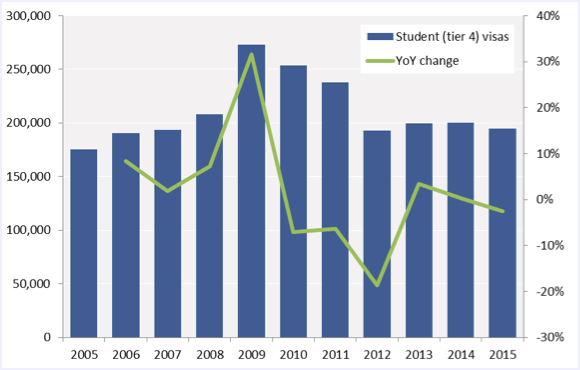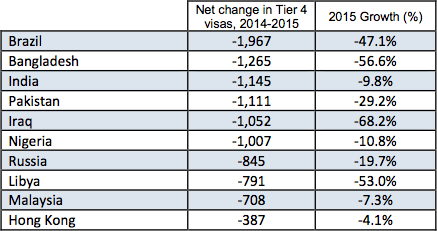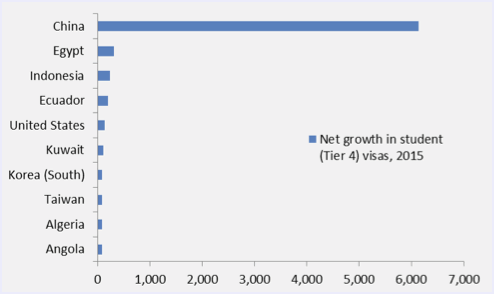Chinese students helped buoy UK study visa issuance in 2015, but how long can one market keep the sector afloat?
UK study visa issuance fell by 2.6 per cent in 2015, marking the first decline since 2012, according to recent data from the Home Office (see Figure 1). While the overall slump was relatively slight, seven of the UK’s top ten recruitment markets registered notably sharper declines, as shown in Figure 2. Indeed, a severe crunch in inward student mobility was only averted thanks to strong growth in China, where visa issuance leapt by 9.6 per cent. With China now accounting for 36 per cent of UK study visas issued globally, a clear mantra is emerging: as China goes, so goes the sector.
Yet the China market will face increasing headwinds in the coming years. The challenges of falling youth population, slowing economic growth, improving domestic higher education quality and increasing competition from major competitor destinations mean that UK and its institutions will have to better refine our offers to match student needs, as well as extend the breadth and depth of our engagements in other markets in order to hedge against shocks in China.
Figure 1 – UK student visa issuance (Tier 4 and equivalents), 2005-2015

Source: Home Office
Note: This table does not include EU countries, as EU citizens do not need a student visa to study in the UK
Figure 2 – Top 10 countries by student visa issuance (Tier 4 and equivalents), 2015

Source: Home Office
The table above shows the UK’s top 10 source countries by student (tier 4) visa issuance. The dominance of China is immediately obvious, accounting for well over a third of all newly issued student visas worldwide and more than five times as many as the next largest country, the United States. This size, combined with a steady increase in outbound study over the past decade, has distorted overall inward mobility trends to the UK. Excluding China, visas issued to students from the rest of the world in 2015 fell by over 8 per cent on average. This trend has persisted for several years – China was responsible for more than three quarters of overall net growth in 2013, and the only reason that student visa issuance grew in 2014 was because the increase from China compensated for the declines elsewhere.
In comparison, most other major sending countries are experiencing downturns in student visa numbers. Of the ten next largest source countries after China, eight saw a decrease in the number of visas issued in 2015, while the remaining two (the United States and South Korea) saw relatively modest growth. Globally, the largest net decline came from Brazil, where the number of students fell by almost 2,000.
South Asian countries are also seeing particularly strong declines, with the number of visas issued to new students from India, Pakistan and Bangladesh each dropping by more than 1,000. This continues the trend seen since the UK’s tightening student visa and post-study work policies, with the number of visas issued to students from these three countries now standing at less than a fifth of the 2010 figure. Other markets have been beset by economic troubles, often related to the declining price of oil.
Figure 3 – Top 10 countries by net decline in student visa issuance, 2015

Source: Home Office
China is not the UK’s only growth market. Visas issued to students from Egypt, Indonesia and Ecuador have seen sustained strong growth over the last few years, while students from the United States, the UK’s second largest sending country, have also increased – perhaps as a result of policies encouraging US undergraduates to spend a year abroad. Nevertheless, the markets seeing strong growth are all relatively small, and the net increase in visas issued to new students from China is more than four times as large as all the next ten growth markets combined (see Figure 4).
Figure 4 – Top 10 countries by net increase in student visa issuance, 2015

Source: Home Office
As a result of these changes, UK universities are becoming increasingly reliant on China. This is especially true in certain subject areas, such as the business and management field, where Chinese students make up more than half of all international students studying finance, and 46 per cent of those studying accounting. The trend is even more pronounced at the Masters level, as almost half of Chinese students in the UK are studying a taught postgraduate course, compared with just 19 per cent of the overall HE population.
The Chinese market, therefore, is critical to UK universities. But there are several challenging trends ahead:
- Slowing economic growth. Chinese economic growth is now at its lowest level in 25 years, and is forecast to dip even further in the next few years, curtailing the rapid expansions in household wealth that have helped fuel the outbound trend. Near-term economic uncertainty may also make growth in outbound students more volatile, forcing institutions to cope with the surges and declines that have characterised Asia’s other major sending markets.
- Improving domestic provision. Our research shows that the quality gap between Chinese and UK universities is the main reason for students to choose to study in the UK1. But quality has taken over from quantity as the Chinese government’s main HE priority, and the government is investing heavily in improving the quality of domestic institutions. Meanwhile, China has historically had comparatively few postgraduate places and high competition for these places, but the government is now focused on expanding postgraduate provision. Over the long term this will also reduce the incentive to study abroad, meaning that overseas universities will have to provide a more attractive and competitive offer to attract Chinese students.
- Declining student-age population. The United Nations Population Division estimates that China’s student-age (15-24) population fell by 22 per cent between 2010 and 2015, and will fall by a further 17 per cent over the next five years. Although the proportion of Chinese young people entering higher education is still rising, the number of Chinese HE students is nearing its peak.
While we expect these factors to gradually suppress growth in China’s outbound student mobility over the 5-10 years, we do not expect an absolute decline. China’s economic growth will still be relatively strong by global standards, and it will remain by far the largest source of international students. None of the downside risks will undercut the premium Chinese families place on quality education, nor will they significantly erode the prestige of international degrees.
In the 2014-15 academic year HESA reported only 2.2 per cent growth in total Chinese HE students in the UK, compared to 8.3 per cent growth in the USA, 3.6 per cent growth in Australia, and 15.9 per cent growth in Chinese students at all levels in Canada. All the UK’s major competitors are investing heavily in China, both through direct student recruitment and through partnerships such as joint degree programmes. There was an even larger gap in total global student mobility, with the UK seeing just 0.6 per cent growth compared to 8 to 11 per cent growth in these three competitor countries. This was mostly driven by a few markets such as India and Nigeria, which saw major declines in mobility to the UK but rapid growth in competitors.
While many factors are likely responsible for recent UK underperformance in key markets, research shows that students view post-study work and immigration options as the UK’s strongest disadvantage when compared to competing study destinations. For example, a 2015 study by Hobsons found that the leading reason for not studying in the UK among students who had previously expressed interest in2the country was post-study work options, followed by the prospects for long-term work and immigration2. Focus groups held by the British Council indicate that only a minority of Chinese students wish to move overseas long-term, but many see overseas work experience as a good way to kick-start their career in China.
Looking forward, it is wise to consider China as a double-edged sword: The UK and its institutions cannot afford to miss out, yet neither can we afford to be overly reliant on what will likely be an increasingly volatile market. In order to grow or maintain a share of China’s outbound mobility, it is now more important than ever for institutions to calibrate their offers to Chinese students’ needs. While ranking is still a primary consideration, we see a growing emphasis on employability, with many students concerned about their prospects once they return home. Proactive approaches to alumni engagement and career counselling services that connect students to the China job market will be increasingly important to attracting quality students.
Unfortunately, there are no straightforward strategies for hedging against shocks in the China market. While several emerging economies show long-term promise, there is not a “next China” on the horizon. Given this reality, UK institutions must embrace a more distributed approach to recruitment, with greater investment and innovation helping to spread in-depth engagement across a larger number of markets. In view of current UK policy, provision of post-study support to ensure positive graduate outcomes in the country of recruitment may be key to maintaining a competitive advantage.
Matt Durnin
Head of Research and Consultancy (East Asia) | British Council
Matt.Durnin@britishcouncil.org.cn
Kevin Prest
Senior Analyst (East Asia) | British Council
Kevin.Prest@britishcouncil.org.cn
1 The British Council’s Student Insight survey shows that “better quality of education/course overseas” is the leading reason for Chinese students to study abroad, while “quality of education” is the top factor in students’ choice of country among those planning to go to the UK. Students in focus groups express similar opinions.
2 Hobsons EMEA, International Student Survey 2015: Value and the Modern Student
